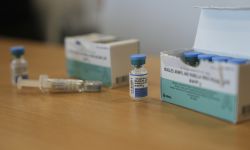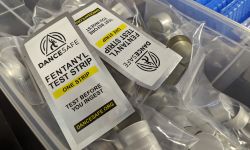With weeks to plan, Grand Rapids learns from Detroit’s coronavirus surge

GRAND RAPIDS—If the coronavirus infection is war, then West Michigan appears to have gained a tactical edge by taking notes as hospitals in Detroit and Chicago waged the first battles with COVID-19.
Since Friday, Kent County recorded 580 confirmed cases, more than suburban Wayne, Oakland or Macomb counties over this period; surpassed only by Detroit, which had 640. On Tuesday, Kent, which includes Grand Rapids, reported 205 new cases, before dropping to 90 on Wednesday.
Still, West Michigan hospitals say they’re ready for the challenge.
“We were fortunate,” said Ronald Grifka, chief medical officer at Metro Health – University of Michigan Health in suburban Grand Rapids. “Having the time to prepare in West Michigan compared to Southeast Michigan has been very helpful.”
- The latest: Michigan coronavirus map, curve, chart, updated COVID-19 news
- Michigan’s latest stay-home order to allow landscaping, boating and golf
- What Gov. Gretchen Whitmer’s stay-at-home executive order means to Michigan
Grand Rapids-based Spectrum Health set up a downtown university building with 250 beds as a backup patient overflow site. Hospitals in the area stocked up on medical gear donated by local businesses. And doctors learned from health care workers to the east in Detroit and west in Chicago on conserving protective gear and trying treatment techniques that hold promise for severe COVID-19 cases.
While West Michigan case volumes are not expected to rival their big-city peers, doctors here say they are optimistic that, despite the recent spike, they will avoid the crush of patients that overwhelmed Detroit hospitals, where bodies had to be stored in refrigerated trucks and Detroit's Sinai-Grace Hospital stacked bodies in spare rooms.
Grifka said hospital models show West Michigan reaching a peak in COVID-19 cases in June — but without the dramatic surge many feared. Grifka said it’s hard to pinpoint that peak number due to uncertainty over residents’ adherence to social distancing and how the virus spreads through spring into summer.
“It looks like it won’t be a spike, but more of a plateau,” he told Bridge Magazine.
As of Wednesday, Spectrum Health — which encompasses 14 hospitals in West Michigan — reported 52 COVID-19 patients with tests pending on 37 others. Mercy Health St. Mary’s in Grand Rapids had 30 cases and Metro Health had three. In Kalamazoo, Bronson Methodist Hospital had 19 cases. Holland Hospital reported six cases.
As a whole, Kent County had 1,395 confirmed cases of COVID-19 and 33 deaths as of Wednesday.
By comparison, Macomb County, one of the suburban Detroit counties to be battered by the virus, has 5,430 confirmed cases and 597 deaths.
At Spectrum Health, Vice President Chad Tuttle said he expects the peak in cases, whenever it comes, to be adequately managed by area hospitals.
“Early on when this started, we thought we would see a rapid escalation in cases. Based on current modeling, we’re seeing a peak that doesn’t look like a chart peak, but looks like a turtle’s back,” he said, a more gentle slope that will not overwhelm hospital capacities.
According to data from the Michigan Department of Health and Human Services, Spectrum, the region’s largest health system, is stocked for now with most of the protective gear needed to fight COVID-19. It reported supplies of 21 days or more for protective masks, shields and gloves. It reported supplies of 0 to six days for protective gowns. Its overall occupancy was 50 percent and it had 30 COVID-19 patients in intensive care units.
Spectrum spokesperson Bruce Rossman said the data on gowns do not reflect that Spectrum uses reusable cloth gowns cleaned by laundry service, adding: “We don’t stock more than seven days of reusable inventory by design.”
According to state data, hospitals in a 13-county region that includes Kent and Ottawa counties had about a third of their 399 ICU beds available, with just 17 percent of their ventilators in use.
Learning from Detroit
In the meantime, Tuttle said, West Michigan doctors were learning battle lessons from colleagues in Southeast Michigan.
As an example, Tuttle said doctors in Detroit hospitals passed along findings that patients on ventilators did better if they were regularly rotated on their stomach.
“Moving people to their stomach for a period of time through the day reduces the workload on the lungs,” he said.
Tuttle said hospitals in the region also benefit from having several more weeks than their peers in Detroit to collect as much personal protection equipment as they could find.
Local business giants chipped in as well. Amway donated hand sanitizer and about 100,000 surgical masks. Grand Rapids-based Steelcase donated masks and face shields it manufactured. Cleaning product manufacturer Bissell, based in suburban Grand Rapids, announced it is donating 1.8 million filters for protective masks for regional hospitals.
At Mercy Health St. Mary’s, President Hyung Kim said officials are prepared to quadruple the number of ICU beds, from 32 beds to more than 120, if needed. Now, he said, all those extra beds likely will not be needed.

“Knock on wood, but we feel prepared,” he said.
Kim said his health system also learned from the experience of doctors in Southeast Michigan.
Among the tips: Place intravenous pumps used to infuse medications in patients in the hallways outside patient rooms. That spares nurses who must regularly check pump levels from having to don face masks and shields to enter COVID patients’ rooms to make adjustments to the pump. It also saves personal protection gear.
“Little insights like that mean a lot,” Kim said.
Taking action early
The rise Kent County is now seeing in COVID-19 can be traced in part to a spike in testing the homeless. In downtown Grand Rapids, health officials began tests on all 250 residents at Mel Trotter Ministries on April 20 and found 69 residents had COVID-19.
Thanks to some forward thinking by community partners, health officials knew what to do. Another homeless shelter, Guiding Light, had offered up its facility about a month ago to quarantine homeless people with COVID-19. Officials were able to transfer those with COVID-19 to Guiding Light, rather than risk them passing the virus to homeless residents in other shelters.
Guiding Light housed nearly 40 homeless COVID-19 patients as of a few days ago.
Stories from the front
Bridge Magazine, the Detroit Free Press and Michigan Radio are teaming up to report on Michigan hospitals during the coronavirus pandemic. We will be sharing accounts of the challenges doctors, nurses and other hospital personnel face as they work to treat patients and save lives.
If you work in a Michigan hospital, we would love to hear from you. You can contact Robin Erb rerb@bridgemi.comat Bridge, Kristen Jordan Shamus kshamus@freepress.com at the Free Press and Kate Wells katwells@umich.edu at Michigan Radio.
“This is a very strategic and important public health intervention which will save lives,” Kent County Health Department Director Adam London told Bridge.
At Metro Health, Grifka, the chief medical officer, said the hospital used these past weeks to try to ensure an adequate supply of masks and installed two cleaning systems — one using hydrogen peroxide mist, the other ultraviolet light — to sterilize N-95 protective masks, the highest standard of protection in medical masks. That allows staffers to safely get multiple uses out of the masks.
Looking west to Chicago
Grifka said doctors also reviewed treatment results in places like Italy and New York City, where city health officials had reported 80 percent of patients put on ventilators died.
“Because the mortality rate was up to 80 percent, we have the ability to say, ‘What if we don’t put them on ventilators?’” Grifka said.
Metro Health doctors in many cases now put patients with falling oxygen levels on nasal oxygen breathing tubes.
“We’ve had much higher survival rates using supplemental oxygen, without putting them on the breathing machine,” he said.
Doctors at a University of Chicago Medicine emergency room on Thursday reported similar results.
According to the University of Chicago health system, treatment of COVID-19 patients in “respiratory distress” with nasal oxygen tubes instead of ventilators showed promising results.
Of 24 such patients treated this way, the officials said, only one required a mechanical ventilator after 10 days of treatment. They theorize that the oxygen tubes reduce damage to the lungs that results from days on a mechanical ventilator.
“The success we’ve had has been truly remarkable,” Michael O’Connor, director of critical care medicine for the University of Chicago Medicine said in a statement.
Grifka said Metro Health is also taking part in a clinical study spearheaded by the Mayo Clinic, investigating transfusion of plasma from recovered COVID-19 patients into the blood of seriously ill patients. The theory: Antibodies from recovered patients will help infected patients fend off the same virus.
On Tuesday, Henry Ford Health System announced it has treated 14 patients since April 17 with this antibody treatment. It said the patients were “progressively improving.”
Grifka said Metro Hospital has thus far treated two patients with transfused plasma. He said one recovered and went home.
“The other one is getting better,” he said.
Like other west Michigan health officials, Grifka credits the response by area residents to Gov. Whitmer’s March 24 shelter-in-place order to the relatively flat growth of COVID-19 cases in the region.
“They have done an incredible job with social distancing,” he said.
West Michigan also likely was spared the international travel exposure of COVID-19 of Detroit, as Detroit International Airport was a hub for travel early in the year from Wuhan, China, and Italy – the first two epicenters for the pandemic. That could have seeded its outbreak in southeast Michigan.
But as the weather improves, and as Michigan’s economy begins to open up, Grifka expects fewer residents to be practicing social distancing. To what extent that happens could influence the volume of COVID-19 patients in the coming weeks.
“We would definitely see a bump in cases,” Grifka said, “but how big a bump is a good question.”
RESOURCES:
- Hey, Michigan, here’s how to make a face mask to fight coronavirus
- Michigan coronavirus dashboard: cases, deaths and maps
- Michigan families can get food, cash, internet during coronavirus crisis
- How to give blood in Michigan during the coronavirus crisis
- 10 ways you can help Michigan hospital workers right now
- Michigan coronavirus Q&A: Reader questions answered
- How to apply for Michigan unemployment benefits amid coronavirus crisis
See what new members are saying about why they donated to Bridge Michigan:
- “In order for this information to be accurate and unbiased it must be underwritten by its readers, not by special interests.” - Larry S.
- “Not many other media sources report on the topics Bridge does.” - Susan B.
- “Your journalism is outstanding and rare these days.” - Mark S.
If you want to ensure the future of nonpartisan, nonprofit Michigan journalism, please become a member today. You, too, will be asked why you donated and maybe we'll feature your quote next time!








